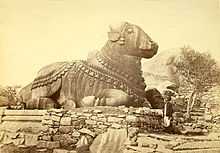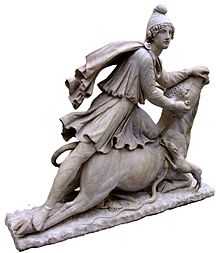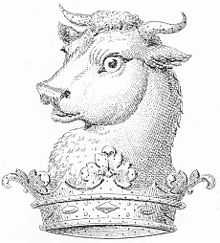Sacred bull


The worship of the Sacred Bull throughout the ancient world is most familiar to the Western world in the Biblical episode of the idol of the Golden Calf. The Golden Calf after being made by the Hebrew people in the wilderness of Sinai, were rejected and destroyed by Moses and the Hebrew people after Moses' time upon Mount Sinai (Book of Exodus). Marduk is the "bull of Utu". Shiva's steed is Nandi, the Bull. The sacred bull survives in the constellation Taurus. The bull, whether lunar as in Mesopotamia or solar as in India, is the subject of various other cultural and religious incarnations, as well as modern mentions in new age cultures.
Stone Age
Aurochs are depicted in many Paleolithic European cave paintings such as those found at Lascaux and Livernon in France. Their life force may have been thought to have magical qualities, for early carvings of the aurochs have also been found. The impressive and dangerous aurochs survived into the Iron Age in Anatolia and the Near East and was worshipped throughout that area as a sacred animal; the earliest survivals of a bull cult are at neolithic Çatalhöyük.
The bull was seen in the constellation Taurus by the Chalcolithic and had marked the new year at springtide by the Bronze Age, for 4000–1700 BCE.
Bronze Age
Mesopotamia
The Sumerian Epic of Gilgamesh depicts the killing by Gilgamesh and Enkidu of the Bull of Heaven, Gugalana, first husband of Ereshkigal, as an act of defiance of the gods. From the earliest times, the bull was lunar in Mesopotamia (its horns representing the crescent moon).[1]
Egypt

In Egypt, the bull was worshiped as Apis, the embodiment of Ptah and later of Osiris. A long series of ritually perfect bulls were identified by the god's priests, housed in the temple for their lifetime, then embalmed and encased in a giant sarcophagus. A long sequence of monolithic stone sarcophagi were housed in the Serapeum, and were rediscovered by Auguste Mariette at Saqqara in 1851. The bull was also worshipped as Mnewer, the embodiment of Atum-Ra, in Heliopolis. Ka in Egyptian is both a religious concept of life-force/power and the word for bull.
Eastern Anatolia
We cannot recreate a specific context for the bull skulls with horns (bucrania) preserved in an 8th millennium BCE sanctuary at Çatalhöyük in eastern Anatolia. The sacred bull of the Hattians, whose elaborate standards were found at Alaca Höyük alongside those of the sacred stag, survived in the Hurrian and Hittite mythologies as Seri and Hurri (Day and Night)—the bulls who carried the weather god Teshub on their backs or in his chariot, and grazed on the ruins of cities.[2]
Crete
The Bull was a central theme in the Minoan civilization, with bull heads and bull horns used as symbols in the Knossos palace. Minoan frescos and ceramics depict the bull-leaping ritual in which participants of both sexes vaulted over bulls by grasping their horns. See also "Minotaur and The Bull of Crete" for a later incarnation to the Minoan Bull.
Indus Valley
Nandi appears in the Hindu mythology as the primary vehicle and the principal gana (follower) of Shiva. Bulls also appear on the Indus Valley seals from Pakistan as well, but most scholars agree that the horned bull on these seals is not identical to Nandi.[3]
Cyprus
In Cyprus, bull masks made from real skulls were worn in rites. Bull-masked terracotta figurines[4] and Neolithic bull-horned stone altars have been found in Cyprus.
Levant
The Canaanite (and later Carthaginian) deity Moloch was often depicted as a bull.
Exodus 32:4 "He took this from their hand, and fashioned it with a graving tool and made it into a molten calf; and they said, 'This is your god, O Israel, who brought you up from the land of Egypt'."
Nehemiah 9:18 "even when they made an idol shaped like a calf and said, 'This is your god who brought you out of Egypt!' They committed terrible blasphemies."
Calf-idols are referred to later in the Tanakh, such as in the Book of Hosea,[5] which would seem accurate as they were a fixture of near-eastern cultures.
King Solomon's "bronze sea" basin stood on 12 brazen bulls.[6][7]
Young bulls were set as frontier markers at Tel Dan and at Bethel the frontiers of the Kingdom of Israel.
Much later, in Abrahamic traditions, the bull motif became a bull demon or the "horned devil" in contrast and conflict to earlier traditions. The bull is familiar in Judeo-Christian cultures from the Biblical episode wherein an idol of the Golden Calf is made by Aaron and worshipped by the Hebrews in the wilderness of Sinai (Exodus). The text of the Hebrew Bible can be understood to refer to the idol as representing a separate god, or as representing the God of Israel himself, perhaps through an association or syncretization with Egyptian or Levantine bull gods, rather than a new deity in itself.[citation needed]
Hellas

When the heroes of the new Indo-European culture arrived in the Aegean basin, they faced off with the ancient Sacred Bull on many occasions, and always overcame him, in the form of the myths that have survived.
In the Olympian cult, Hera's epithet Bo-opis is usually translated "ox-eyed" Hera, but the term could just as well apply if the goddess had the head of a cow, and thus the epithet reveals the presence of an earlier, though not necessarily more primitive, iconic view.Schliemann,1976 Classical Greeks never otherwise referred to Hera simply as the cow, though her priestess Io was so literally a heifer that she was stung by a gadfly, and it was in the form of a heifer that Zeus coupled with her. Zeus took over the earlier roles, and, in the form of a bull that came forth from the sea, abducted the high-born Phoenician Europa and brought her, significantly, to Crete.
Dionysus was another god of resurrection who was strongly linked to the bull. In a cult hymn from Olympia, at a festival for Hera, Dionysus is also invited to come as a bull, "with bull-foot raging." "Quite frequently he is portrayed with bull horns, and in Kyzikos he has a tauromorphic image," Walter Burkert relates, and refers also to an archaic myth in which Dionysus is slaughtered as a bull calf and impiously eaten by the Titans.[8]
For the Greeks, the bull was strongly linked to the Bull of Crete: Theseus of Athens had to capture the ancient sacred bull of Marathon (the "Marathonian bull") before he faced the Bull-man, the Minotaur (Greek for "Bull of Minos"), whom the Greeks imagined as a man with the head of a bull at the center of the labyrinth. Minotaur was fabled to be born of the Queen and a bull, bringing the king to build the labyrinth to hide his family's shame. Living in solitude made the boy wild and ferocious, unable to be tamed or beaten. Yet Walter Burkert's constant warning is, "It is hazardous to project Greek tradition directly into the Bronze age";[9] only one Minoan image of a bull-headed man has been found, a tiny seal currently held in the Archaeological Museum of Chania.
In the Classical period of Greece, the bull and other animals identified with deities were separated as their agalma, a kind of heraldic show-piece that concretely signified their numinous presence.
Eucharist analogies
Walter Burkert summarized modern revision of a too-facile and blurred identification of a god that was identical to his sacrificial victim, which had created suggestive analogies with the Christian Eucharist for an earlier generation of mythographers:
- The concept of the theriomorphic god and especially of the bull god, however, may all too easily efface the very important distinctions between a god named, described, represented, and worshipped in animal form, a real animal worshipped as a god, animal symbols and animal maskes used in the cult, and finally the consecrated animal destined for sacrifice. Animal worship of the kind found in the Egyptian Apis cult is unknown in Greece. ("Greek Religion," 1985).
Iron Age
Roman Empire


The bull is one of the animals associated with the late Hellenistic and Roman syncretic cult of Mithras, in which the killing of the astral bull, the tauroctony, was as central in the cult as the Crucifixion was to contemporary Christians. The tauroctony was represented in every Mithraeum (compare the very similar Enkidu tauroctony seal). An often-disputed suggestion connects remnants of Mithraic ritual to the survival or rise of bullfighting in Iberia and southern France, where the legend of Saint Saturninus (or Sernin) of Toulouse and his protégé in Pamplona, Saint Fermin, at least, are inseparably linked to bull-sacrifices by the vivid manner of their martryrdoms, set by Christian hagiography in the 3rd century CE, which was also the century in which Mithraism was most widely practiced.
In some Christian traditions, Nativity scenes are carved or assembled at Christmas time. Many show a bull or an ox near the baby Jesus, lying in a manger. Traditional songs of Christmas often tell of the bull and the donkey warming the infant with their breath. This refers (or, at least, is referred) to the beginning of the book of the prophet Isaiah, where he says: "The ox knoweth his owner, and the ass his master's crib." (Isaiah 1:3)
Celts
A prominent zoomorphic deity type is the divine bull. Tarvos Trigaranus ("bull with three cranes") is pictured on reliefs from the cathedral at Trier, Germany, and at Notre-Dame de Paris. In Irish mythology, the Donn Cuailnge ("Brown Bull of Cooley") plays a central role in the epic Táin Bó Cuailnge ("The Cattle-Raid of Cooley") which features the hero Cú Chulainn, which were collected in the 7th century CE Lebor na hUidre ("Book of the Dun Cow").
Pliny the Elder, writing in the first century AD, describes a religious ceremony in Gaul in which white-clad druids climbed a sacred oak, cut down the mistletoe growing on it, sacrificed two white bulls and used the mistletoe to cure infertility:[10]
| “ | The druids — that is what they call their magicians — hold nothing more sacred than the mistletoe and a tree on which it is growing, provided it is Valonia oak…. Mistletoe is rare and when found it is gathered with great ceremony, and particularly on the sixth day of the moon….Hailing the moon in a native word that means ‘healing all things,’ they prepare a ritual sacrifice and banquet beneath a tree and bring up two white bulls, whose horns are bound for the first time on this occasion. A priest arrayed in white vestments climbs the tree and, with a golden sickle, cuts down the mistletoe, which is caught in a white cloak. Then finally they kill the victims, praying to a god to render his gift propitious to those on whom he has bestowed it. They believe that mistletoe given in drink will impart fertility to any animal that is barren and that it is an antidote to all poisons.[11] | ” |
Iberia
Macrobius lists the bull as an animal sacred to the god Neto/Neito, possibly being sacrifices to the deity.[12]
Notes
- ↑ Jules Cashford, The Moon: Myth and Image 2003, begins the section "Bull and cow" pp 102ff with the simple observation "Other animals become epiphanies of the Moon because they look like the moon.... the sharp horns of a bull or cow were seen to match the pointed curve of the waxing and waning crescents so exactly that the powers of the one were attributed to the other, each gaining the other's potency as well as their own."
- ↑ Hawkes and Woolley, 1963; Vieyra, 1955
- ↑ Prafullah Padhy (1 January 2006). Social Legislation And Crime. Gyan Books. p. 15. ISBN 978-81-8205-347-2. Retrieved 5 February 2013.
- ↑ Burkert 1985
- ↑ "Hosea 10:5 The people who live in Samaria fear for the calf-idol of Beth Aven. Its people will mourn over it, and so will its idolatrous priests, those who had rejoiced over its splendor, because it is taken from them into exile". Bible.cc. Retrieved 2012-10-30.
- ↑ "1 Kings 7:25 The Sea stood on twelve bulls, three facing north, three facing west, three facing south and three facing east. The Sea rested on top of them, and their hindquarters were toward the center". Bible.cc. Retrieved 2012-10-30.
- ↑ "Jeremiah 52:20 The bronze from the two pillars, the Sea and the twelve bronze bulls under it, and the movable stands, which King Solomon had made for the temple of the LORD, was more than could be weighed". Bible.cc. Retrieved 2012-10-30.
- ↑ Burkert 1985 pp. 64, 132
- ↑ Burkert 1985 p. 24
- ↑ Miranda J. Green. (2005) Exploring the world of the druids. London: Thames & Hudson. ISBN 0-500-28571-3. Page 18-19
- ↑ Natural History (Pliny), XVI, 95
- ↑ Macrobius, Saturnalia, Book I, XIX
See also
- Bucranium
- Bugonia
- Camahueto
- Cattle in religion
- Deer (mythology)
- Red heifer
- Taurobolium
References
- Burkert, Walter, Greek Religion, 1985
- Campbell, Joseph Occidental Mythology "2.The Consort of the Bull", 1964.
- Hawkes, Jacquetta; Woolley, Leonard: Prehistory and the Beginnings of Civilization, v. 1 (NY, Harper & Row, 1963)
- Vieyra, Maurice: Hittite Art, 2300-750 B.C. (London, A. Tiranti, 1955)
- Jeremy B. Rutter, The Three Phases of the Taurobolium, Phoenix (1968).
- Heinrich Schliemann, "Troy and its Remains" (NY, Arno Press, 1976) pp. 113–114.
External links
- An exhibit on the tombs of Alaca Höyük at the Metropolitan Museum of Art includes one example of the bull standards.
- Bull Tattoo Art The image of the bull in tattoo art.
